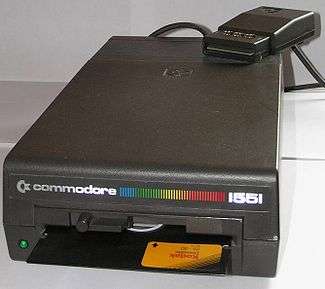Commodore 1551
The Commodore 1551 (originally introduced as the SFS 481) is a floppy disk drive for the Commodore Plus/4 home computer. It resembles a charcoal-colored Commodore 1541 and plugs into the cartridge port, providing faster access than the C64/1541 combination. Commodore reportedly planned an interface to allow use of the 1551 with the C64, but it was never released.


.jpg)
Aside from faster access, the drive is very similar to the 1541. Like the 1541, it is a single-sided 170-kilobyte drive for 5¼" disks, with each disk split into 664 256-byte blocks available for user data plus 19 blocks for DOS data and directory; the file system makes each block its own cluster.
Hardware
The disk drive uses group coded recording and contains an MOS Technology 6510T processor as a disk controller. The 6510T is a specialized version of the 6510 processor used in the C64, and it is only used in the 1551. The DOS limits the number of files per disk to 144 regardless of the number of free blocks on the disk because the directory is of a fixed size, and the file system does not allow for subdirectories. Its DOS is compatible with the 1541, so disks written by one drive can be utilized in the other.
The 1551 has no dip switches to change the drive's device number. If a user added more than one drive to a system, they had to open the case and cut a trace in the circuit board to permanently change the drive's number, or hand-wire an external switch to allow it to be changed externally. It is possible to connect a maximum of two 1551s to one computer.
Popularity
The 1551 is less common than other Commodore disk drives. The 1541 was more readily available as it is compatible with the popular C64 and VIC-20, so many people opted to use 1541s with the Plus/4. Since the 1551 is compatible only with the Plus/4, which was a poor seller in the United States, few were made. In Europe, the Plus/4 was much more successful, but because tape drives were the most popular storage device in Europe in the 1980s, the 1551 was not very popular in Europe either.